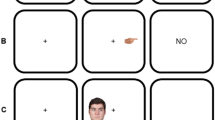Abstract
Gaze alternation (GA) is considered a hallmark of pointing in human infants, a sign of intentionality underlying the gesture. GA has occasionally been observed in great apes, and reported only anecdotally in a few monkeys. Three squirrel monkeys that had previously learned to reach toward out-of-reach food in the presence of a human partner were videotaped while the latter visually attended to the food, a distractor object, or the ceiling. Frame-by-frame video analysis revealed that, especially when reaching toward the food, the monkeys rapidly and repeatedly switched between looking at the partner’s face and the food. This type of GA suggests that the monkeys were communicating with the partner. However, the monkeys’ behavior was not influenced by changes in the partner’s focus of attention.


Similar content being viewed by others
References
Anderson JR, Kuroshima H, Kuwahata H, Fujita K, Vick S-J (2001) Training squirrel monkeys (Saimiri sciureus) to deceive: Acquisition and analysis of behavior toward cooperative and competitive trainers. J Comp Psychol 115:282–293
Bates E, Camaioni L, Volterra V (1975) The acquisition of preformatives prior to speech. Merrill-Palmer Quart 21:205–226
Blaschke M, Ettlinger G (1987) Pointing as an act of social communication by monkeys. Anim Behav 35:1520–1523
Call J, Tomasello M (1994) The production and comprehension of referential pointing by orangutans (Pongo pygmaeus). J Comp Psychol 108:307–317
Franco F, Butterworth G (1996) Pointing and social awareness: declaring and requesting in the second year. J Child Lang 23:307–336
Gomez J-C (1996) Ostensive behavior in great apes: the role of eye contact. In: Russon AE, Bard KA, Parker ST (eds) Reaching into thought: the minds of the great apes. Cambridge University Press, Cambridge, pp 131–151
Hess M, Novak MA, Povinelli DJ (1993) ‘Natural pointing’ in a rhesus monkey, but no evidence of empathy. Anim Behav 46: 1023–1025
Kumashiro M, Ishibashi H, Itakura S, Iriki A (2002) Bidirectional communication between a Japanese monkey and a human through eye gaze and pointing. Curr Psychol Cogn 21:3–32
Krause MA, Fouts RS (1997) Chimpanzee pointing: hand shapes, accuracy, and the role of eye gaze. J Comp Psychol 111:330–336
Leavens DA, Hopkins WD, Bard KA (1996) Indexical and referential pointing in chimpanzees (Pan troglodytes). J Comp Psychol 110:346–353
Leavens DA, Hopkins WD (1999) The whole-hand point: the structure and function of pointing from a comparative perspective. J Comp Psychol 113:417–425
Leavens DA, Russell JL, Hopkins WD (2005) Intentionality as measured in the persistence and elaboration of communication by chimpanzees (Pan troglodytes). Child Develop 76:291–306
Liszkowski U, Carpenter M, Henning A, Striano T, Tomasello M (2004) Twelve-month-olds point to share attention and interest. Develop Sci 7:297–307
Mitchell RW, Anderson JR (1997) Pointing, withholding information, and deception in capuchin monkeys (Cebus apella). J Comp Psychol 111:351–361
Povinelli DJ, Theall LA, Reaux JE, Dunphy-Lelii S (2003) Chimpanzees spontaneously alter the location of their gestures to match the attentional orientation of others. Anim Behav 66:71–79
Acknowledgements
This study was supported by JSPS Grants-in-Aid for Scientific Research Nos. 13410026 and 17300085 to KF and 21st Century COE Program, D-10 to Kyoto University, and by awards from the Carnegie Trust for the Universities of Scotland and the Great Britain Sasakawa Foundation to JRA. The assistance of Hika Kuroshima with analyses and illustrations is gratefully acknowledged.
Author information
Authors and Affiliations
Corresponding author
Rights and permissions
About this article
Cite this article
Anderson, J.R., Kuwahata, H. & Fujita, K. Gaze alternation during “pointing” by squirrel monkeys (Saimiri sciureus)?. Anim Cogn 10, 267–271 (2007). https://doi.org/10.1007/s10071-006-0065-0
Received:
Revised:
Accepted:
Published:
Issue Date:
DOI: https://doi.org/10.1007/s10071-006-0065-0




